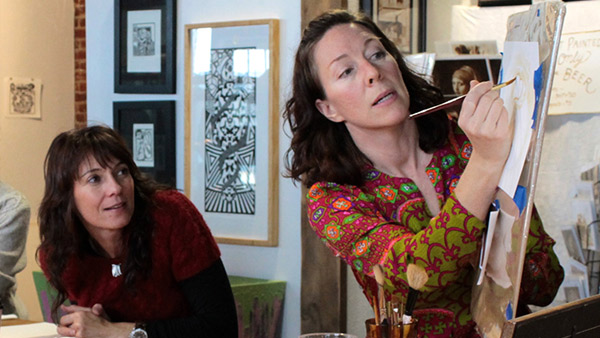
Karen Eland, The Beer Painter, started experimenting with different paint mediums about 15 years ago. In 1998, she had a flash of inspiration while painting in a coffeeshop—if coffee can stain, maybe you could use it to paint. Pleased with the results, Eland began experimenting with other beverages such as tea, beer and liquor.
When she moved to Bend, Oregon, home to scores of breweries, Eland felt she had to experiment with beer painting. She fell in love with the rich colors of brown that beer can produce and, although it’s a picky, delicate medium, it mostly paints like watercolors. Beer painting has led her on far and adventurous journeys to London, San Diego, and more. Check out her five tips and tricks for beer painting below!
1. Choose Your Favorite Porter or Stout
Open up your favorite porter or stout. Take a swig. If you can’t stop there, drink that one and open up your least favorite porter or stout instead. Dump that one out into a bowl. You can dunk your paintbrush right in and start! Or if you want a pro-secret, microwave the beer about a minute at a time to condense it to an even darker, thicker ‘paint’.
Words of Inspiration
Have you ever been enjoying a delicious beer and thought “I wish I could make this last?” Now you can! I was captivated by the rich, dark shades of a porter in 2008 and decided to paint with it. The results were worth framing, so I’ve kept at it ever since. My experiment has led all around the world, and somehow I still haven’t become tired of the color brown.
– Karen Eland, The Beer Painter
2. Watercolor paper is key
Watercolor paper is key. The beer won’t be able to soak into a canvas. I love Arches brand 140lb or 300lb watercolor paper. They have been making paper since 1492, so they know how to do it!
3. Work light to dark
It’s best to work light to dark. You will build up several layers to get the darkest areas, and you can add water to do the lighter areas.
4. Mistakes are easy to correct
Unlike watercolors, the beer will come back off the paper to some degree. This means you can correct a mistake by adding a small amount of water with a clean brush onto the area you want to remove. Blot immediately with a clean paper towel and your spot will be much lighter. Or use this technique on purpose to create interesting light-on-dark effects.
5. Protect your work
Spray your completed painting (after it is thoroughly dry) with a UV-varnish such as Krylon UV Resistant Clear. Make sure to frame it with a mat or spacers so it doesn’t touch the glass directly.
Watch!
The Brewers Association (BA) commissioned Eland to create two paintings for their offices in Boulder, Colo. To create the paintings (one of which you can watch in the time-lapse below) Eland used an imperial stout brewed by BA staff. You can also find her work on Etsy.





Share Post